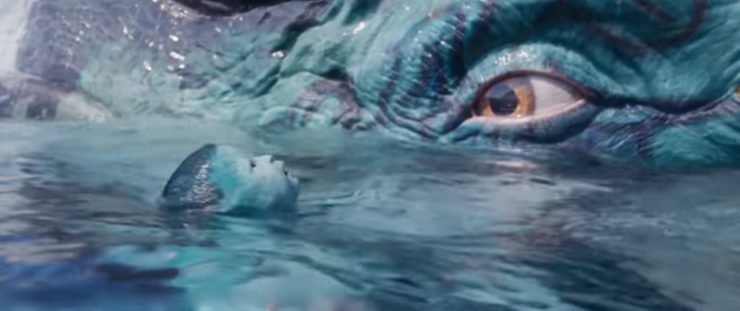We’ve noticed that Avatar: The Way of Water has made quite the splash (not sorry) with their whale-like alien creatures. Whaliens, if you will. Or, as the more common parlance would dub them: space whales. Yes, even if they don’t exist in space, the term applies.
But Avatar is certainly not the first story to think of whales and go “oh wow, these would be even cooler not on Earth.” After all, science fiction has been into environmentalism and space-ifying the flora and fauna of this planet forever. Here are just a few of our favorite friends that Avatar’s tulkuns now join in ranks.
Doctor Who’s Star Whales
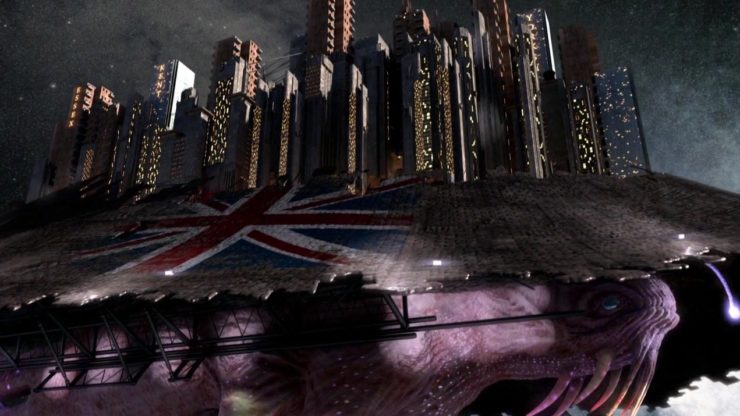
In a blatant rip-off of not one, but two other SF stories, Doctor Who’s “The Beast Below” gives us the star whale—the last of its kind, being used to move about the Starship UK in a future where humanity has left the Earth behind in cobbled together starship cities. While the whale came to help humanity, hearing the cries of its children, humans in their infinite wisdom did not perceive this, and believed that they could only keep the whale if they made it a slave. So it’s very much like Ursula K. Le Guin’s “The Ones Who Walk Away From Omelas” but also similar to a graphic novel by Rick Veitch titled Abraxas and the Earthman, where a seemingly hostile space whale named Abraxas only turns out to be dangerous because humans have been torturing him. Thankfully, the star whale is far less vengeful and stays with the Starship UK once the Doctor and Amy Pond have freed it. Not that humans particularly deserve its kindness after all that. The Whoniverse has a bad track record with space whale types all over, too: think of the poor creature being used for an endless supply of food that team Torchwood encounters in “Meat.”
The Culture’s Dirigible Behemothaur
Iain M. Banks’ Culture novels contain more than one example of space whales, but the dirigible behemoutaurs are basically air whales that are some of the largest known creatures in the galaxy. The behemothaurs contain their own entire symbiotic ecosystems, and sometimes have the beings that call them home perform as translators to the outside galactic population. They come from Airspheres, which are space habitats of unknown origin that are basically giant membranes filled with atmosphere and artificial light sources. Airspheres are ideal for housing very large forms of life, including the behemothaurs and aeronauthaurs.
Star Trek’s Humpback Whales
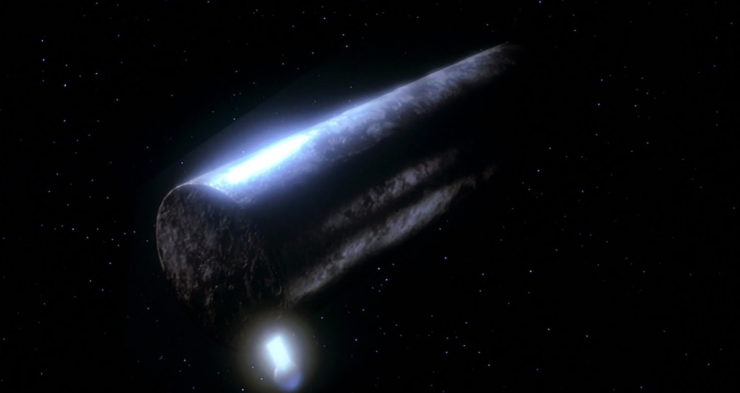
According to Star Trek IV: The Voyage Home, whales—at least of the humpback variety—are actually aliens from another world. This is something that humanity learns the hard way when a probe arrives in the 24th century to find out where their buddies went, only to receive no answer… because they’ve been extinct for hundreds of years due to humanity’s fishing practices. Cue the Enterprise crew (currently wanted for numerous crimes after saving their beloved Spock) heading back in time to rescue a couple of whales and bring them into the future to communicate with said probe. They befriend a woman who has devoted her entire life to one of San Francisco’s marine institutes, almost lose Chekov to Cold War politics, and use a Klingon Bird of Prey to scare the hell out of a whaling boat, but it all turns out worth it when George and Gracie arrive in the future to presumably far less polluted oceans.
Dune’s Space Fur Whales
In Dune, there’s a reference to House Harkonnnen “manipulating space whale fur prices,” which is enough to make anyone excited because the space whales have fur??? Later novels insist that these whales don’t live in space, but are just whales with fur from the planet Lankiveil, which is honestly disappointing. But they still count for being the only furred whalien we’ve ever heard tell of.
Marvel’s Acanti
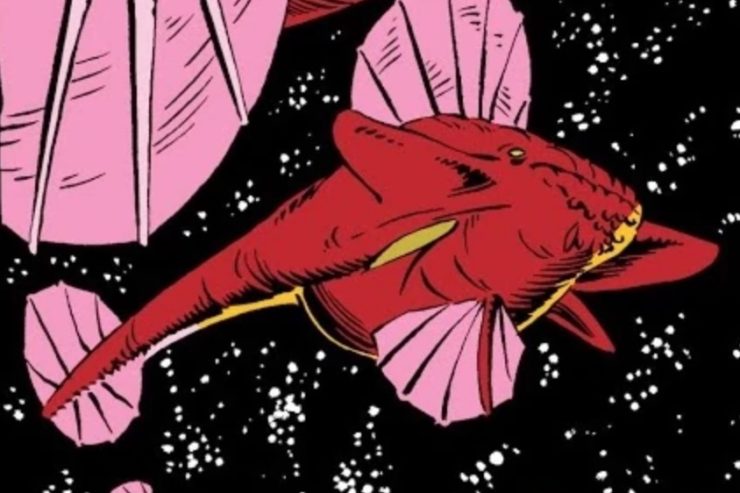
The Acanti are Marvel Comics’ answer to the space whale, one of the oldest beings in the universe, and among the first to develop sentience. They are peaceful, and this leads to their enslavement by the Brood, who see them as a means to faster-than-light travel (because they have the biological ability to do that, of course). The X-Men eventually show up to aid them, helping their Prophet-Singer cross over properly by releasing its soul; Acanti typically do this by hurling their bodies into stars when they are close to death, and the Prophet-Singer was prevented from doing this by the Brood. Following this, the Acanti are capable of freeing themselves from enslavement. The gargantuan mounts used by the Chitauri army in The Avengers are actually a species bred from a combination of Acanti and Starshark genetics.
Radiance’s Callowhales
Trying to explain Catherynne M. Valente’s callowhales is like trying to explain Radiance, the book they appear in: they are many things at once, a mystery, a necessity, something playful and brilliant and dark and likely to defy anything approaching a linear timeline. But in the briefest of takes: in a past that feels like the future, the massive callowhales live on Venus and are key to humanity’s existence across the planets and stars. Divers milk them; the milk is full of good stuff that helps humans live in space. They are part of the book’s central mystery—the disappearance of filmmaker Severin Unck—but they are also a mystery unto themselves. “It is not really milk. It is not really a whale,” Valente writes at one point. And when she explains what a callowhale is, via a film-within-the-book, it’s only one of the majestic cinematic spectacles caught, like the callowhales themselves, between these pages.
Farscape’s Budongs
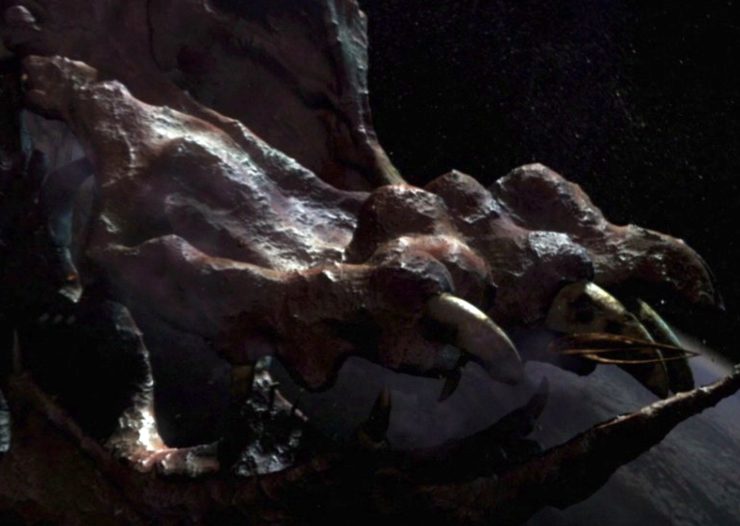
The budongs are giant creatures (they can grow to be the size of small moons, which does in fact lead to “that’s no moon, that’s a—” jokes because John Crichton knows what we want), even larger than leviathan ships like Moya, and they crop up more than once in Farscape for decidedly whale-like shenanigans. The first time we encounter a budong is actually via its corpse; the creatures are so large and contain so many resources in their bodies that dead budongs are frequently mined in space, their skeletal remains serving as makeshift space stations. Later on, the crew on Talon get swallowed by a live one, however, and they go through a series of increasingly awful plans to try and get out of the creature’s belly, eventually resorting to the old-fashioned solution: making the poor thing throw up.
Star Wars’ Purrgil
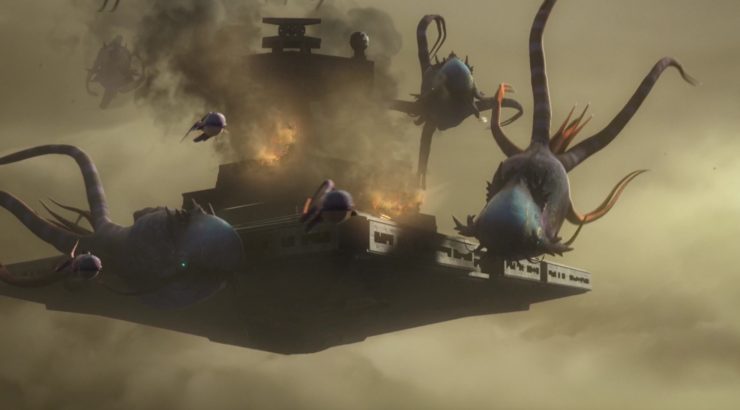
The purrgil are considered pests by most spacers in the Star Wars galaxy because they have a tendency to get in the way of starship flight paths and cause deaths. As a result, many pilots shoot at purrgils on sight, not viewing them as sentient. But when the Ghost crew encounters them, Ezra Bridger makes a connection to the creatures and finds that they are gentle beings that are incredibly connected to the Force. They are also capable of hyperspace travel, and legends suggest that seeing purrgils in flight was part of what inspired other species to develop lightspeed-fast ships of their own. Ezra’s connection with the purrgil winds up being so profound that he uses this bond to call for their aid in a last battle against Grand Admiral Thrawn on Lothal; directing three of them to wrap tentacles around Thrawn’s ship and hyperspace jump them to distances and parts unknown…
Hitchhiker’s Guide to the Galaxy’s Whale
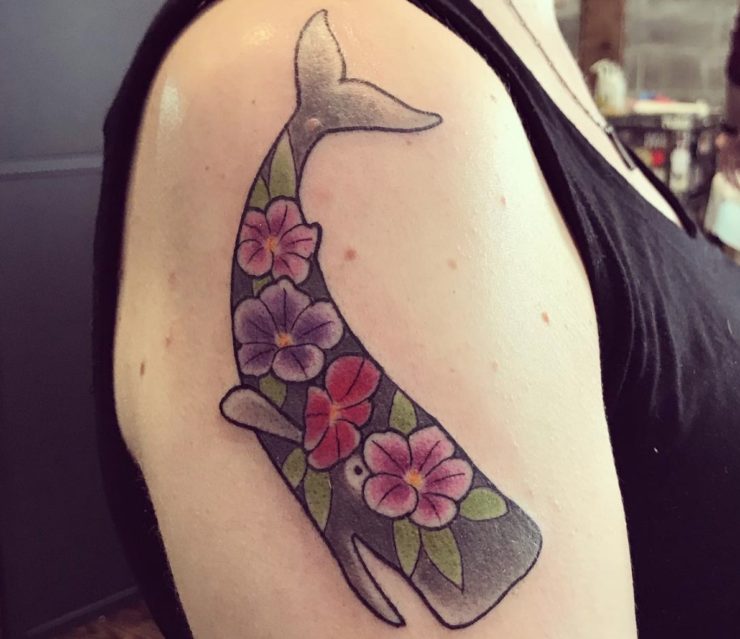
Some might argue that this whale is hardly a whalien given that it is by all accounts a regular Earth whale who just happens to be called into being directly above a planet, but that’s not really relevant. The point is that said whale gets only moments to contemplate its existence while plummeting to an untimely death, and questions of how physics should be acting on this creature are unimportant when said space whale is serving as a perfect metaphor for how quickly life passes us all by. Thanks, Douglas Adams. (Image above is of Molly’s excellent tattoo of this whale friend.)
So there are some of our favorite space whales… while we have you here, though—have you considered space turtles?? The Great A’Tuin carrying the Discworld would like a word.










